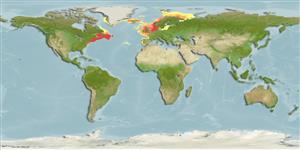Classification / Names
Common names from other countries
Main reference
Size / Weight / Age
Max length : 112 cm TL male/unsexed; (Ref. 5951); common length : 35.0 cm TL male/unsexed; (Ref. 4645); max. published weight: 16.8 kg (Ref. 9988); max. reported age: 20 years (Ref. 4645)
Length at first maturity
Lm 34.9 range ? - ? cm
Environment
Marine; demersal; oceanodromous (Ref. 51243); depth range 10 - 450 m, usually 10 - 200 m (Ref. 35388)
Climate / Range
Temperate, preferred 6°C (Ref. 107945); 79°N - 35°N, 76°W - 52°E
Distribution
Northeast Atlantic: Bay of Biscay to Spitzbergen; in the Barents Sea to Novaya Zemlya; around Iceland; rare at the southern Greenland. Northwest Atlantic: Cape May, New Jersey to the Strait of Belle Isle.
Countries | FAO areas | Ecosystems | Occurrences | Introductions
Short description
Dorsal
spines
(total): 0;
Anal
spines: 0. Mouth relatively small; lower jaw shorter than the upper jaw; chin barbel rather small. Lateral line dark, uninterrupted to about the end of the body. Lateral-line pores present on head. Scales overlapping. A large dark blotch is above the pectoral fin just below the lateral line.
IUCN Red List Status (Ref. 115185)
Threat to humans
Harmless
Human uses
Fisheries: highly commercial; aquaculture: experimental; gamefish: yes
Tools
Special reports
Download XML
Internet sources
Estimates of some properties based on models
Phylogenetic diversity index
PD50 = 1.0000 many relatives (e.g. carps) 0.5 - 2.0 few relatives (e.g. lungfishes)
Trophic Level
4.0 ±0.1 se; Based on diet studies.
Resilience
Medium, minimum population doubling time 1.4 - 4.4 years (rm=0.54-1.2; K=0.12-0.30; tm=2-6.5; tmax=20; Fec=100,000)
Vulnerability
Moderate to high vulnerability (47 of 100)
Price category
